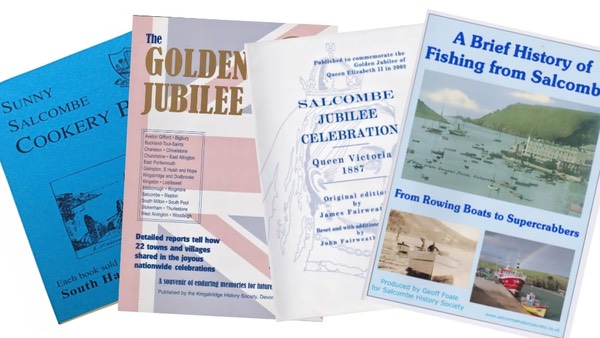
Rosemary Griggs
‘A WOMAN OF NOBLE WIT’
The story of Katherine Champernowne, presented by Rosemary Griggs
TUESDAY, 30th SEPTEMBER 2025 | 7 for 7.30 PM | SALCOMBE RUGBY CLUB, Camperdown Road, Salcombe, TQ8 8AX
Everyone Welcome | Admission: members free, £5 non-members | info@salcombehistorysociety.co.uk
The story of Katherine Champernowne, mother of Sir Humphrey Gilbert and Sir Walter Raleigh. Devon was rocked by the religious and social changes that shaped Tudor England; privateers and pirates; rebellions and plots. How Katherine became the woman who inspired her famous sons to follow their dreams. Tudor history seen though a woman’s eyes.
Rosemary Griggs is an author, researcher, seamstress and popular West Country speaker: https://rosemarygriggs.co.uk/.

Queen Elizabeth I

Sir Humphrey Gilbert, son of Katherine Champernowne by her first marriage to Otho Gilbert of Compton, Greenway and Galmpton
Sir Humphrey Gilbert, son of Katherine Champernowne by her first marriage to Otho Gilbert of Compton, Greenway and Galmpton
Sir Humphrey Gilbert (c.1539 – 9th September 1583) was an English adventurer, explorer, member of parliament and soldier who was a pioneer of the English colonies in North America and the Plantations of Ireland.
A.L. Rowse wrote of Gilbert: “He was passionate and impulsive, a nature liable to violence and cruelty – as came out in his savage repression of rebels in Ireland – but also intellectual and visionary, a questing and original mind, with the personal magnetism that went with it. People were apt to be both attracted and repelled by him, to follow his leadership and yet be mistrustful of him.”

Sir Walter Raleigh, son of Katherine Champernowne by her second marriage to Walter Raleigh of Fardel Manor
Sir Walter Raleigh (c.1553 – 29th October 1618) was a great English hero, statesman, soldier, writer and explorer. One of the most notable figures of the Elizabethan age, he played a leading part in English colonisation of North America, suppressed rebellion in Ireland, helped defend England against the Spanish Armada and held senior political posts under Queen Elizabeth I.
His good fortune did not long survive the Queen’s death on 24th March 1603. Raleigh was arrested on 19th July 1603 at the Old Exeter Inn in Ashburton, charged with treason for his part in the Main Plot against King James I, and imprisoned in the Tower of London. He was convicted, but King James spared his life, and Raleigh remained imprisoned in the Tower until 1616.
In 1617, Raleigh was pardoned by the King and granted permission to conduct a second expedition in search of El Dorado. However, a detachment of Raleigh’s men attacked the Spanish, in violation of peace treaties with Spain and against Raleigh’s orders. A condition of Raleigh’s pardon was avoidance of hostility against Spain. The Spanish demanded that Raleigh’s death sentence be reinstated by King James, who had little choice but to do so.
Raleigh was beheaded in the Old Palace Yard at the Palace of Westminster on 29th October 1618. After he was shown the axe, he said: “This is a sharp Medicine, but it is a Physician for all diseases and miseries.” Raleigh’s last words, spoken to the hesitating executioner, were: “What dost thou fear? Strike, man, strike!”
Steam Rally – 9th and 10th August 2025
Photos and video from the 2025 Steam Rally by Geoff Foale.

Roger Barrett, Chair of the Museum, and Ken Prowse, President of the History Society, on the joint History Society-Museum stand at the Steam Rally

Steam Rally

Steam Rally

Steam Rally

Steam Rally

Steam Rally
Geoff Foale made this video at the Steam Rally: https://vimeo.com/1114493727.
Kingsbridge Show – 6th September 2025

Ken Prowse on the joint History Society-Museum stand at Kingsbridge Show
The Fairweathers of Salcombe – Alfred Fairweather (1876-1959)
Alfred Fairweather, one of the four sons of James Fairweather (see Issue 34), was originally apprenticed to a pharmacist in Kingsbridge and trained at Stewarts, Dispensing Chemists, at 56 Fore Street.

Alfred Fairweather
Alfred did not complete his training, instead teaching himself photography, and set up his own photography business in Robinson’s Row in 1900, to the rear of his father’s business at 67 Fore Street.
He would walk long distances with his heavy camera and equipment in search of a good picture, then develop and print his own photographs. Alfred chronicled life in Salcombe, the people, their houses and streets and the many events and celebrations on land and sea which characterise how the people of the town lived at that time.
He produced postcards and developed a business in studio portraits from a shop he set up at 8 Fore Street by 1926, which he ran until it was damaged by enemy action on 12th March 1943.
“The roar of a plane was followed by a deafening explosion, and his shop and two others next to it were destroyed. If a customer had delayed him for a few moments longer, he would almost certainly have been killed. As it was, he was quickly on the scene with other rescuers, and sifted through the rubble of his shop to salvage as many as he could have his hundreds of negatives. Inevitably, some were smashed beyond repair.” (Kingsbridge & Salcombe Gazette)
The Fairweather Collection can be explored at the Cookworthy Museum, Kingsbridge, a unique record, rich in detail, of Salcombe life over the first half of the twentieth century: https://kingsbridgemuseum.org.uk/

Alfred Fairweather
2026 History Society Calendar
The Society’s 2026 Calendar is now on sale! Printed on high quality glossy paper, every month features beautiful large images of Salcombe through the ages. This is a must-have for anyone who loves Salcombe and an ideal present. You can buy it for £9.99 at Ashby’s of Salcombe, Bonningtons, Salcombe Maritime Museum, Salcombe Information Centre, Spar on Loring Road.
Possible History Society merger with Salcombe Maritime Museum
The History Society Committee is considering a proposal to merge the Society with Salcombe Maritime Museum for the mutual benefit of members, to create a stronger, single charity for Salcombe’s history. If this proposal goes ahead, it will need to be approved by members of the Society and the Museum at their AGMs. Charity Commission consent will also be required.
Images of Rosemary Griggs courtesy of Rosemary Griggs. Images of Queen Elizabeth I by unknown continental artist c.1575, Sir Humphrey Gilbert by Magdalena de Passe or Willem de Passe 1620 and Sir Walter Raleigh by Nicholas Hilliard c. 1585 courtesy of National Portrait Gallery, licensed under Creative Commons. Images and video from the Steam Rally courtesy of Geoff Foale. Image from Kingsbridge Show courtesy of Roger Barrett. Information and images of Alfred Fairweather courtesy of Cookworthy Museum and Kingsbridge & Salcombe Gazette.







0 Comments